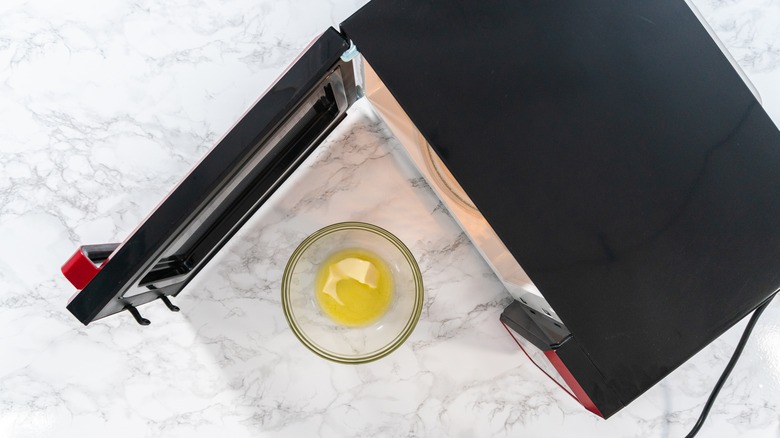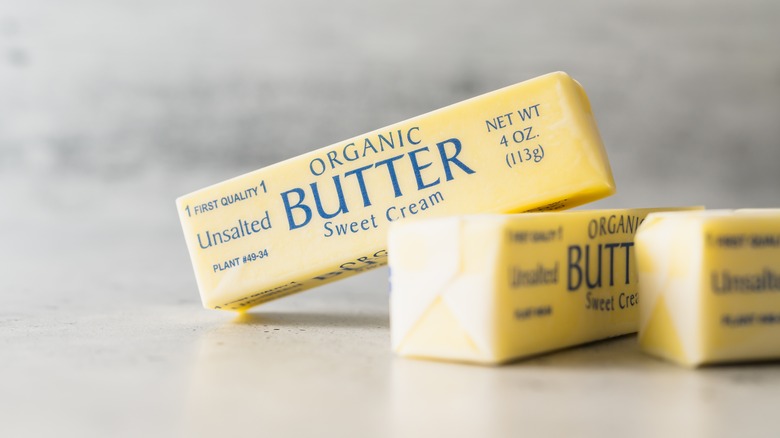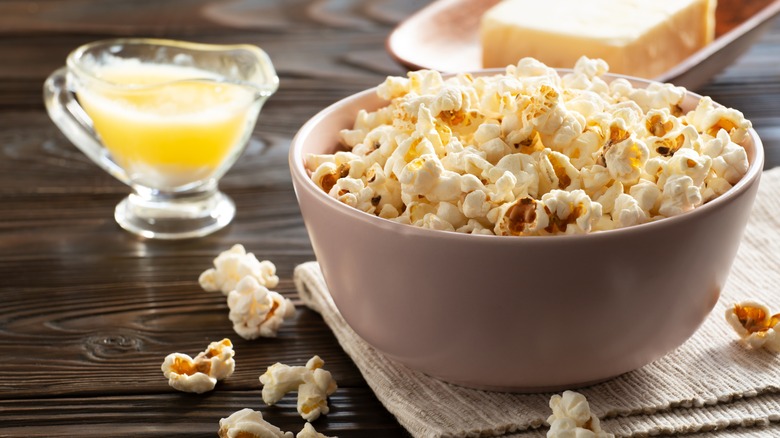The Butter Wrapper Hack For Mess-Free Microwave Melting
Using the microwave to melt butter is one of the little conveniences in the kitchen that most of us can agree just makes life easier. If you're like us, however, you've probably experienced microwaved butter gone wrong: That moment when you hear the pop and crackle indicator of a buttery mess coming from your appliance and know your convenient microwave step just cost you extra time and effort scrubbing the inside of your microwave's now-greasy walls.
This annoying splattering can happen when microwaving butter due to the separation of water and fat during the melting process. Though butter is mostly fat, an average stick can contain between 10 and 18% water. In the heat of the microwave, the water droplets contained in butter heat up rapidly, creating steam that wants to escape while the stick turns from solid to liquid form.
Luckily, microwaving butter doesn't have to take this messy turn. Some home cooks call for topping your bowl of butter with a paper towel to create a protective barrier that allows steam to vent and escape as the butter melts. But for a quick trick and way to generate less kitchen waste, use what you already have. To avoid the butter-splattered mess, make the most of your stick of butter and use the wrapper (as long as it's not the metallic type) as a lid to your microwave-safe container when melting the decadently rich ingredient.
How to seamlessly melt butter in the microwave
To easily melt butter in the microwave without the unrelentingly slick mess, first cut your butter into smaller pieces, or tablespoons. This will help the butter melt more quickly and evenly. Place your butter pieces in a microwave-safe bowl or glass measuring cup that is large enough to support the melted butter, without overflowing. Next, take the wrapper from your butter and place it over the top of your butter-filled bowl to make a loose tent that will prevent splatters and allow steam to vent and safely escape while your butter melts.
Equally important to your container coverage are your microwave settings and procedure. To avoid overheating the water and fat in your stick of butter as it melts, heat your butter at 10 to 30-second intervals, using your microwave at 40% power. Check on the butter frequently, and heat it just until almost completely melted (if there are little bits of butter that remain, just give the mixture a stir, and the solid specs should dissolve and melt away). Though this takes a couple more microwave button presses and close attention, trust us when we say melting butter this way will save you from a splattered butter mess.
How to use melted butter in your recipes
Once you have melted your butter in the microwave using the wrapper as a butter splatter vent and barrier, you won't want to look back. From here you'll be able to go on with a variety of recipes, without the headache of extra cleaning.
To achieve the best chocolate chip cookies with a chewy and crisp exterior that makes for the perfect bite, some chefs say melted butter is key. When using butter melted in the microwave for baking recipes though, it's essential to take the extra couple of minutes to cool the melted butter and let it sit before mixing into your batter. This ensures your butter isn't scorching hot and avoids cooking ingredients in your recipe like eggs and milk.
For many savory dishes, the cooling step isn't always necessary, and you can often use your melted butter the right way. For instance, when preparing homemade soy sauce popcorn, melted butter can be directly removed from the microwave and mixed with soy sauce, then drizzled atop a big bowl of popcorn to make for an extra rich movie-time snack with extra savory flavor depth.


